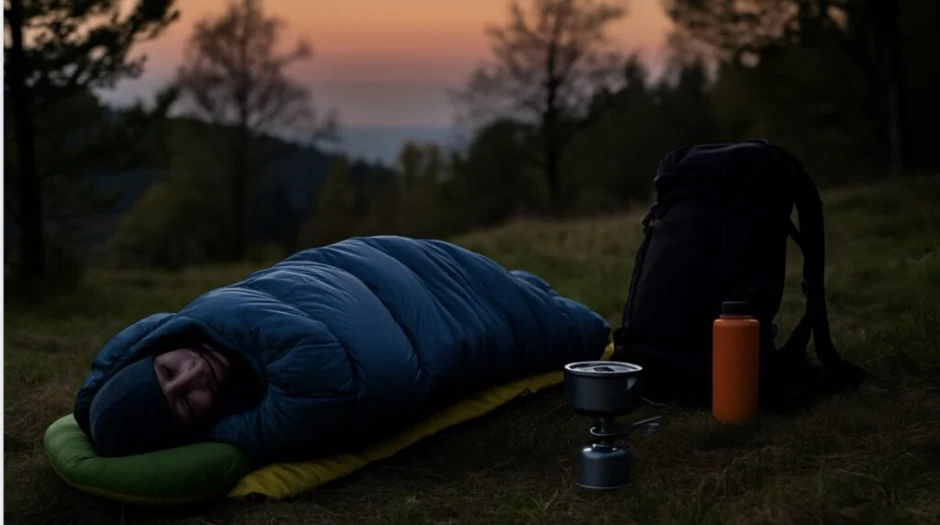Why are more people fascinated by sleeping outdoors? In an overstimulated, urbanized world, the longing for simplicity, grounding, and nature grows stronger. Sleeping under the stars has become a minimalist counterpoint to daily life: no electricity, no noise, no digital overload. What once began as camping has evolved—today, people sleep without tents, on balconies, in bivvy sacks in the forest, or under tarps in open fields. But this freedom only becomes meaningful when it’s approached with responsibility and preparation. That’s where G.Business begins its analysis.
Legal status: where is sleeping under the open sky allowed
In Germany, wild camping is mostly prohibited. Regulations differ by state and protection status. Sleeping is banned in national parks and nature reserves. Agricultural land is also off-limits. Legal options include designated trekking campsites or private property with permission.
Examples of legal spots for sleeping:
| Location | Allowed? | Notes |
|---|---|---|
| Trekking sites (e.g., Palatinate, Eifel) | Yes | Often bookable online, max. 1 night |
| Balcony, roof, private garden | Yes | Legal on private property |
| City parks | No | Considered an administrative offense |
| Private land (without permission) | No | Counts as trespassing |
Choosing the right spot: safety first
A low-hanging branch or a damp ditch can turn your night into a nightmare. Choose flat, dry, protected areas, away from trails, animal paths, or feeding spots. Ensure the route back is manageable even in the dark.
Checklist for a safe sleeping spot:
- No dead wood or branches overhead
- No hollows or wet areas
- Wind and visual protection
- Not on trails or game paths
Example: In the Black Forest, trekking camps are set up ~200 meters off trail—ideal for quiet yet accessible rest.
Weather and climate: planning prevents hypothermia
Even in July, temperatures can drop below 10°C at night. Wind and dampness are dangerous, especially for beginners. Always check local forecasts, avoid exposed locations, and bring dew and wind protection.
Weather guidelines:
| Conditions | Recommendation |
|---|---|
| >10°C, calm | Good for beginners |
| <5°C, high humidity | Only for experienced campers |
| Thunderstorm risk | Postpone sleeping outdoors |
Equipment: minimal, but thoughtful
A bivvy sack isn’t a tent but provides protection from rain and wind. Synthetic sleeping bags perform better in humidity than down. A sleeping mat is essential to retain body warmth. Smart packing matters more than quantity.
Basic overnight gear:
- Sleeping bag (comfort down to 5°C)
- Sleeping mat (at least 1.5 cm thick)
- Bivvy sack or tarp
- Headlamp with spare batteries
- First-aid kit, signal whistle
- Insect repellent and tick check tools
Animals and insects: how to avoid encounters
Wild boars? Unlikely. Mosquitoes, ants, and ticks? More realistic. Avoid still water, field edges, and strong scents. Store food in scent-proof containers and avoid perfumed toiletries.
Protection tips:
- Mosquito net or bivvy with insect screen
- Long sleeves, light-colored clothing
- Tick checks morning and night
- Airtight food storage (drybags or sealed tins)
Hygiene and health: staying clean without a bathroom
Even without running water, hygiene is possible. Wet wipes, biodegradable soap, and a small toiletry kit are sufficient. The main danger is hypothermia from wet clothes or low activity. Pack warm spare clothing.
Minimal hygiene kit:
- Soap, cloth, toothbrush in a pouch
- Toilet paper, bags, small shovel
- Spare socks and underwear
Making fire? Better not.
Open fire is banned in 14 of 16 German federal states, especially in forests or dry zones. Penalties are high. Use solar or LED lamps and thermal clothing instead.
Fire-free alternatives:
- Solar lamp or LED lantern
- Hot tea in a thermos
- Hand warmers inside sleeping gear
Urban sleeping: balcony, terrace, rooftop
You don’t need a forest to try outdoor sleeping. Start on your balcony—safe, legal, and controlled. Rooftops and courtyards work too. A great trial run for families.
Urban sleeping advantages:
- Bathrooms nearby
- No gear transport
- Wind shelter from buildings
- Family-friendly test environment
Leave no trace: act responsibly
A clean campsite leaves no trace. Take everything with you. Don’t bury plastics or damage plants. Even biodegradable products can harm water ecosystems.
Golden rules:
- Bring trash bags
- Bury waste with soil or leaves
- Don’t uproot or cut plants
- Double-check the site when leaving
Reflection and repetition: learning with every bivouac
The first night may be rough, but experience brings comfort. Keep notes after every outing—what worked, what didn’t, what you forgot. This process builds awareness and skill.
Post-night reflection questions
- What was useful? What wasn’t?
- What did I miss?
- Where did I plan poorly?
- How did my body react?
Outdoor sleeping isn’t a romantic adventure—it’s a conscious practice of simplicity, responsibility, and connecting with nature. True freedom lies where planning meets humility.
Stay connected for news that works — timely, factual, and free from opinion — and insights that matter now: What Is a Robotic Lawn Mower – and 7 Reasons Garden Owners Are Choosing One in 2025
